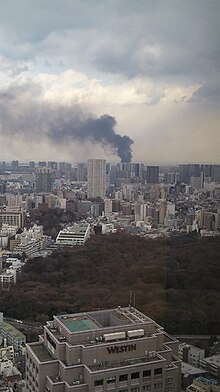2011 Tōhoku earthquake and tsunami: Difference between revisions
No edit summary |
m Reverted edits by 24.25.215.48 (talk) to last version by Nico86roma |
||
| Line 25: | Line 25: | ||
|landslide = |
|landslide = |
||
|aftershocks = Multiple |
|aftershocks = Multiple |
||
|casualties = |
|casualties = unknown |
||
}} |
}} |
||
Revision as of 08:07, 11 March 2011
This article documents a current event. Information may change rapidly as the event progresses, and initial news reports may be unreliable. The latest updates to this article may not reflect the most current information. (March 2011) |
 | |
| UTC time | ?? |
|---|---|
| Magnitude | 8.9 Mw |
| Depth | 15.2 mi (24 km) |
| Epicenter | 38°19′19″N 142°22′08″E / 38.322°N 142.369°E |
| Areas affected | Japan |
| Tsunami | Yes |
| Aftershocks | Multiple |
| Casualties | unknown |
The 2011 Sendai, Japan earthquake was an 8.9 magnitude earthquake[1], measured 7 on the JMA seismic intensity scale]][2]. It was located off the east coast of Tohoku, Japan on Friday, March 11, 2011 at 05:46:23 UTC at a depth of 24.4 km (15.2 miles)[3]. Originally a 7.9, it was upgraded to an 8.8, then again to an 8.9 by the United States Geological Survey.[1]
The earthquake


The earthquake occurred on 130 km (80 miles) east of Sendai, Honshu, Japan. It presented a possibility of triggering tsunami in several countries including Japan. Its epicenter was 373 kilometers (231 miles) from Tokyo, the United States Geological Survey said. A 7.7 aftershock was reported 30 minutes following the initial quake.
As a result of the quake, smoke could be seen rising from a building in Tokyo port while Shinkansen bullet trains stopped (no de-railments have happened) and Haneda Airport suspended operation after the quake struck.[4] Various trains all around Japan were also stopped. A large fire broke out at an oil refinery in Ichihara, Chiba prefecture. The quake also rattled buildings and toppled cars off bridges and into waters underneath. Most elevators were stopped in buildings as result of the earthquake.
Tsunami
The earthquake triggered a tsunami warning for Japan's pacific coast and various other countries, including New Zealand, Australia, Russia, Guam, Philippines, Indonesia, Papua New Guinea, Nauru, Hawaii and Northern Marianas (USA) and Taiwan. The tsunami warning issued by Japan was the most serious on its warning scale, implying that the wave was expected to be 10 meters high.[5] A 0.5 meter high wave hit Japan's northern coast.[6] Kyodo news agency has reported a 4 metre tsunami hitting Iwate Prefecture in Japan. Waves have flooded the Miyagi prefecture, picking up cars and buildings along its path.[7]
At 9:28 p.m (HST) the National Weather Service issued a tsunami warning until 7 a.m. for all of Hawaii.[8] Tsunami waves are expected to arrive in Hawaii at 3 am local time.
See also
References
- ^ a b "Magnitude 8.9 - NEAR THE EAST COAST OF HONSHU, JAPAN 2011 March 11 05:46:23 UTC". 11 March 2011. Retrieved 11 March 2011.
- ^ "東北を中心に震度7の地震 宮城県で4・2メートルの津波 建物も流される". MSN産経ニュース. 2011-03-11. Retrieved 11 March 2011.
- ^ "Tsunami hits north-eastern Japan after massive quake". 11 March 2011. Retrieved 11 March 2011.
- ^ "Japan issues top tsunami warning after major quake". MediaCorp Channel NewsAsia. 11 March 2011. Retrieved 11 March 2011.
- ^ "Japan hit by massive earthquake". BBC News. 2011-03-11.
- ^ "Quake causes many injuries in Japan, tsunami". Reuters. 2011-03-11.
- ^ http://www.heraldsun.com.au/news/japan-on-tsunami-alert-after-another-quake/story-e6frf7jo-1226019884379
- ^ http://www.prh.noaa.gov/pr/hnl/
